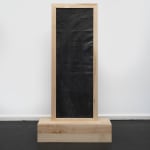Rindon Johnson
Paths wind through woods. Dogs chase their tails. Smiles light up faces. Laughs echo loudly. Dreams take flight. Hopes rise high. Waves roll gently. Children skip merrily. Words convey thoughts. Maroon. Time heals wounds. Minds seek answers. Fates twist and turn. Truths reveal slowly. Lives unfold daily. Manifestation is such a chore. Say it a loud, see it how mouths: a companionable environment can engender impressive thirstiness, 2023
Ash wood, leather, crayon, oil, colored pencil, acrylic and wax
188.5 x 100 x 24.5 cm
74 1/4 x 39 3/8 x 9 5/8 inches
74 1/4 x 39 3/8 x 9 5/8 inches
Copyright The Artist
Photo: Marjorie Brunet Plaza
Weitere Abbildungen
„Paths wind through woods. Dogs chase their tails. […]“ (2023) ist eine freistehende Skulptur aus Leder, bei der Johnson die Haut beidseitig bearbeitet und in einen Rahmen aus Eschenholz spannt....
„Paths wind through woods. Dogs chase their tails. […]“ (2023) ist eine freistehende Skulptur aus Leder, bei der Johnson die Haut beidseitig bearbeitet und in einen Rahmen aus Eschenholz spannt. Die anthrazitfarbene Oberfläche des Leders wirkt auf den ersten Blick wie eine Schiefertafel, die immer wieder neu beschriftet werden kann und die Johnson mit Kreiden bearbeitet. Die Verwendung der Kuhhaut als Grundlage der Zeichnung weckt zudem Assoziationen mit Pergament, dem Vorgänger des Papiers bei dem eine dünne Tierhaut seit dem Altertum als Schreibmaterial verwendet wird. Die Kuhhaut wird hier zur Skulptur, zur Malerei und gleichzeitig zum architektonischen Element. Dabei ist das Leder aber nicht nur Leinwand, sondern symbolisiert ebenso den kulturellen Einfluss des tierischen Materials. Mit der Materialwahl nimmt sich Johnson der Häute an und verweist durch deren Präsentation auf die vielfältige Ressource und der daraus resultierenden Unterwerfung, Vernachlässigung und Austauschbarkeit der Lebewesen durch die Menschen. Der eigentliche Akt der Häutung, eine gewaltsame Überschreitung der Körpergrenzen, veranschaulicht diese Form der Objektivierung. Johnson unterstreicht mit den Arbeiten aus Leder die Anerkennung der Handlungsfähigkeit von Tieren und stellt Ethik und Nachhaltigkeit unserer profitorientierten Interessen in Zusammenhang mit tierischen Produkten in Frage. Gleichzeitig überträgt „Paths wind through woods. Dogs chase their tails. […]“ diese Fragen auf identitätspolitische und klassistische Themen, sowie Praktiken der rassistischen Ausbeutung.
“Paths wind through woods. Dogs chase their tails. [...]” (2023) is a freestanding sculpture made of leather, in which Johnson works the hide on both sides and stretches it into a frame made of ash wood. At first glance, the anthracite-colored surface of the leather looks like a chalkboard that can be rewritten over and over again. The use of cowhide as the basis of the drawing also evokes associations with parchment – the predecessor of paper – in which a thin animal skin has been used as writing material since ancient times. Here the cowhide becomes sculpture, painting, and at the same time, an architectural element. However, the leather is not only a canvas, but it also symbolizes the cultural influence of the animal material. With the choice of material, Johnson takes on the skins and, through their presentation, refers to the multifaceted resource and the resulting subjugation, neglect, and interchangeability of living creatures by humans. The actual act of skinning, a violent transgression of bodily boundaries, exemplifies this form of objectification. Johnson's works in leather underscore the recognition of animals' agency and question the ethics and sustainability of our profit-driven interests in relation to animal products. At the same time, “Paths wind through woods. Dogs chase their tails. [...]” transfers these questions to identity politics, class issues, and practices of racial exploitation.
“Paths wind through woods. Dogs chase their tails. [...]” (2023) is a freestanding sculpture made of leather, in which Johnson works the hide on both sides and stretches it into a frame made of ash wood. At first glance, the anthracite-colored surface of the leather looks like a chalkboard that can be rewritten over and over again. The use of cowhide as the basis of the drawing also evokes associations with parchment – the predecessor of paper – in which a thin animal skin has been used as writing material since ancient times. Here the cowhide becomes sculpture, painting, and at the same time, an architectural element. However, the leather is not only a canvas, but it also symbolizes the cultural influence of the animal material. With the choice of material, Johnson takes on the skins and, through their presentation, refers to the multifaceted resource and the resulting subjugation, neglect, and interchangeability of living creatures by humans. The actual act of skinning, a violent transgression of bodily boundaries, exemplifies this form of objectification. Johnson's works in leather underscore the recognition of animals' agency and question the ethics and sustainability of our profit-driven interests in relation to animal products. At the same time, “Paths wind through woods. Dogs chase their tails. [...]” transfers these questions to identity politics, class issues, and practices of racial exploitation.













